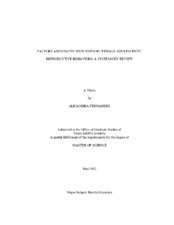| dc.description.abstract | It is clear that the US federal government is concerned about the country's teen pregnancy rates and would like to see changes. Without a precise understanding of the factors associated with adolescent pregnancy, and specifically with Hispanic female adolescent pregnancy, monies allocated to prevention programs could go to waste.
The focus of this study was to systematically review the current literature as it relates to factors, in this case attitudes, beliefs and practices that influence Hispanic female adolescents' reproductive behaviors. This study consisted of systematically reviewing published studies, through a process of abstracting and organizing their findings into a matrix. Three electronic databases were searched: MEDLINE, ERIC, and CINAHL. The initial search yielded a total of 494 publications. After applying specific inclusion criteria, the final sample of publications included forty-nine (n=49). Publications were categorized as primarily quantitative or primarily qualitative studies. Methodological characteristics of each study were judged using an overall methodological quality score (MQS) assigned to each study. Different MQS criteria were developed for qualitative and quantitative studies.
A total of 205 findings were abstracted from the 49 included reports. Beliefs that were identified consistently among the studies were norms and values associated with condom use, partner's beliefs, hedonistic beliefs, and communicative beliefs. Norms and values were also seen as important when adolescents chose to remain abstinent. Findings that were unique the Hispanic adolescent population were identified as well with cultural factors showing significant associations.
Regarding methodological quality, fewer than 50% of studies included a theoretical framework and only 11 included Hispanic-only samples. Qualitative studies had similar findings to those of the quantitative studies, but also introduced new factors associated with reproductive behaviors. Acculturation constructs were seen among the qualitative studies as being positively associated to sexual abstinence. Other behaviors such as partner's manipulation of birth control and the use of female condoms were unique to the qualitative studies done in this review.
This review provided a critical assessment of the literature and it methodological qualities. Findings should be interpreted with caution due to limitations. Concentrating on unique factors associated with the Hispanic population can lead to interventions that are culturally sensitive to this population and effective. Health professionals should focus on conducting more studies with exclusively Hispanic samples and use factors unique to the Hispanic population when planning health education programs that are culturally sensitivity to Hispanic female adolescents' needs and world-views. | en |


